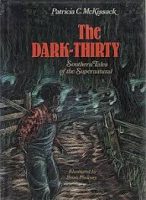 Sharon reviews The Dark Thirty, Southern Tales of the Supernatural by Patricia McKissack,.Knopf, 1992, 166 pages
Sharon reviews The Dark Thirty, Southern Tales of the Supernatural by Patricia McKissack,.Knopf, 1992, 166 pages
Grady hated driving the bus in the snow. Hated driving the Hall Street Express route, with its twisting turns, that are especially treacherous in winter. Just as he decided to finish for the night, a young woman came running up to the bus door. She wasn’t dressed for the bitter cold, and she was clutching a baby to her chest. Eula Mae Daniels begged Grady to take her to a hospital, her baby had a fever. Grady agreed until he learned she didn’t have the fare. Feeling tired, angry and ready to go home, he didn’t listen to her pleas and ordered her back off the bus. In the paper the next morning, he read that a young mother and her baby had died in the snow the night before. One year later, to the day, Grady was driving the Hall Street Express again, in the snow. He couldn’t believe his eyes when he saw the same woman running up to the bus, still holding a crying baby. Angrily, he gunned the engine, not noticing the icy patch in the street, and was killed when his bus crashed.
Twenty-five years later, the story of Eula Mae had become a legend. Every year, on the night of the first snow, she appeared on Hall Street, trying to get a ride to the hospital for her baby who was sick. This was Ray’s first time to see her, his first year driving for the Metro. When he saw her approaching the bus, he had to decide what to do.
What would you do?
Patricia McKissack describes the “dark thirty” as the 30 minutes between the sun’s setting and the dark. As a child, she and her siblings had that 30 minutes to get home. When they made it, their grandmother would tell them a ghost story while sitting on the porch.






